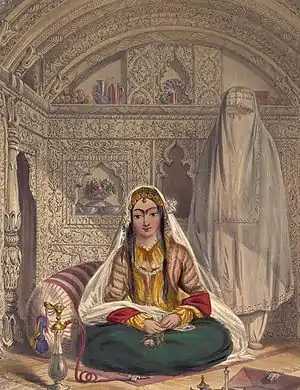Harem
Harem (Arabic: حريم ḥarīm, "a sacred inviolable place; harem; female members of the family")[1][2] properly refers to domestic spaces that are reserved for the women of the house in a Muslim family.[3][4][5] This private space has been traditionally understood as serving the purposes of maintaining the modesty, privilege, and protection of women. A harem may house a man's wife or wives, their pre-pubescent male children, unmarried daughters, female domestic workers, and other unmarried female relatives. In royal harems of the past, concubines of the prince were also housed in the harem. In former times some harems were guarded by eunuchs who were allowed inside. The structure of the harem and the extent of monogamy or polygamy has varied depending on the family's personalities, socio-economic status, and local customs.[3] Similar institutions have been common in other Mediterranean and Middle Eastern civilizations, especially among royal and upper-class families,[4] and the term is sometimes used in other contexts.[6] In traditional Persian residential architecture the women's quarters were known as andaruni (Persian: اندرونی; meaning inside, and in the Indian subcontinent as zenana (Persian: زنانه).
Although the institution has experienced a sharp decline in the modern era due to a rise in education and economic opportunities for women, as well as Western influences, seclusion of women is still practiced in some parts of the world, such as rural Afghanistan and conservative states of the Persian Gulf region.[7][4]
In the West, Orientalist imaginary conceptions of the harem as a hidden world of sexual subjugation where numerous women lounged in suggestive poses have influenced many paintings, stage productions, films and literary works.[3][4] Some earlier European Renaissance paintings dating to the 16th century portray the women of the Ottoman harem as individuals of status and political significance.[8] In many periods of Islamic history, women in the harem exercised various degrees of political power,[9] such as the Sultanate of Women in the Ottoman Empire.
Terminology
The word has been recorded in the English language since early 17th century. It comes from the Arabic ḥarīm, which can mean "a sacred inviolable place", "harem" or "female members of the family". In English the term harem can mean also "the wives (or concubines) of a polygamous man." The triliteral Ḥ-R-M appears in other terms related to the notion of interdiction such as haram (forbidden), mahram (unmarriageable relative), ihram (a pilgrim's state of ritual consecration during the Hajj) and al-Ḥaram al-Šarīf ("the noble sanctuary", which can refer to the Temple Mount or the sanctuary of Mecca).[10]
In Turkish of the Ottoman era, the harem, i.e., the part of the house reserved for women was called haremlik, while the space open for men was known as selamlık.[11]
The practice of female seclusion is not exclusive to Islam, but the English word harem usually denotes the domestic space reserved for women in Muslim households.[12][13] Some scholars have used the term to refer to polygynous royal households throughout history.[14]
The ideal of seclusion
.jpg.webp)
Leila Ahmed describes the ideal of seclusion as a "a man's right to keep his women concealed—invisible to other men." Ahmed identifies the practice of seclusion as a social ideal and one of the major factors that shaped the lives of women in the Mediterranean Middle East. [15] For example, contemporary sources from the Byzantine Empire describe the social mores that governed women's lives. Women were not supposed to be seen in public. They were guarded by eunuchs and could only leave the home "veiled and suitably chaperoned." Some of these customs were borrowed from the Persians, but Greek society also influenced the development of patriarchal tradition.[16]
The ideal of seclusion was not fully realized as social reality. This was in part because working class women often held jobs that required interaction with men.[12] In the Byzantine empire, the very ideal of gender segregation created economic opportunities for women as midwives, doctors, bath attendants and artisans, since it was considered inappropriate for men to attend to women's needs. At times women lent and invested money and engaged in other commercial activities. [17] Historical records shows that the women of 14th-century Mamluk Cairo freely visited public events alongside men, despite objections of religious scholars.[12] The practice of gender segregation in Islam was influenced by an interplay of religion, customs and politics.[7][12]
Female seclusion has historically signaled social and economic prestige.[12] Eventually, the norms of female seclusion spread beyond the elites, but the practice remained characteristic of upper and middle classes, for whom the financial ability to allow one's wife to remain at home was a mark of high status.[7][12] In some regions, such as the Arabian peninsula, seclusion of women was practiced by poor families at the cost of great hardship, but it was generally economically unrealistic for the lower classes.[7]
Where historical evidence is available, it indicates that the harem was much more likely to be monogamous. For example, in late Ottoman Istanbul, only 2.29 percent of married men were polygynous, with the average number of wives being 2.08. In some regions, like Sub-Saharan Africa and Southeast Asia, prevalence of women in agricultural work leads to wider practice of polygyny, but makes seclusion impractical. In contrast, in Eurasian and North African rural communities that rely on male-dominated plough farming, seclusion is economically possible but polygyny is undesirable. This indicates that the fundamental characteristic of the harem is seclusion of women rather than polygyny.[18]
Pre-Islamic origins
The idea of the harem or seclusion of women did not originate with Muhammad or Islam.[9] The practice of secluding women was common to many Ancient Near East communities, especially where polygamy was permitted.[19] In pre-Islamic Assyria, Persia, and Egypt, most royal courts had a harem, where the ruler’s wives and concubines lived with female attendants, and eunuchs.[9] Encyclopædia Iranica uses the term harem to describe the practices of the ancient Near East.[20]
In Assyria, rules of harem etiquette were stipulated by royal edicts. The women of the harem lived in seclusion, guarded by eunuchs, and the entire harem traveled together with the king. A number of regulations were designed to prevent disputes among the women from developing into political intrigues.[20]
Female seclusion and a special part of the house reserved for women were common among the elites of ancient Greece (where it was known as the gynaeceum).[21][22] These traditions were taken up in the Byzantine empire, though the rigid norms of seclusion expressed in Byzantine literature did not necessarily reflect actual practice.[21][23]
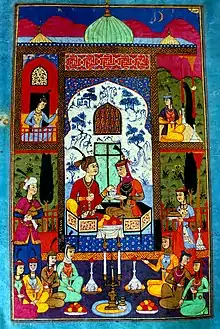
There is no evidence of harem practices among early Iranians, but Iranian dynasties adopted them after their conquests in the Middle East. According to Greek sources, the nobility of the Medes kept no less than five wives who were watched over by eunuchs.[20] Greek historians report that Persian notables of the Achaemenid empire as well as the king himself had several wives and a larger number of concubines. The Old Persian word for the harem is not attested, but it can be reconstructed as xšapā.stāna (lit. night station or place where one spends the night). The chief consort, who was usually the mother of the heir to the throne, was in charge of the household. She had her own living quarters, revenues, and a large staff. Three other groups of women lived in separate quarters: the other legal wives, royal princesses, and concubines.[20] The Achaemenid harem served as a model for later Iranian empires, and the institution remained almost unchanged. Little is known about the harems of the Parthians, but the information about the Sasanian harem reveals a picture that closely mirrors Achaemenid customs. A peculiar characteristic of the Sasanian royalty and aristocracy, which was attested in later times under the Safavid and Qajar empires, was that the highest female rank was not necessarily given to the chief wife, but could be held by a daughter or a sister.[20]
According to Sasanian legend, of all the Persian kings, Khosrow II was the most extravagant in his hedonism. He searched his realm to find the most beautiful girls, and it was rumored that about 3,000 of them were kept in his harem. This practice was widely condemned and it was counted as one of the crimes for which he was later tried and executed. Khosrow himself claimed that he sent his favorite wife Shirin every year to offer them a possibility of leaving his harem with a dowry for marriage, but that their luxurious lifestyle always prompted them to refuse his offer.[20]
South Asian traditions of female seclusion, called purdah, may have been influenced by Islamic customs, but the practice of segregation by gender in Hindu society predates the Muslim conquests in the Indian subcontinent.[24] Ashoka, the emperor of the Mauryan Dynasty in India, kept a harem of around 500 women. Once when a few of the women insulted him, he had all of them burnt to death.[25]
In Islamic cultures
Umayyad and Abbasid Caliphates
The harem system first became fully institutionalized in the Islamic world under the Abbasid caliphate.[7] Seclusion of women was established in various communities of the Mediterranean, Mesopotamia, and Persia before the advent of Islam,[7] and some scholars believe that Muslims adopted the custom from the Byzantine Empire and Persia, retrospectively interpreting the Quran to justify it.[26] Although the term harem does not denote women's quarters in the Quran, a number of Quranic verses discussing modesty and seclusion were held up by Quranic commentators as religious rationale for the separation of women from men, including the so-called hijab verse (33:53).[7][27] In modern usage hijab colloquially refers to the religious attire worn by Muslim women, but in this verse it meant "veil" or "curtain" that physically separates female from male space.[28][12] Although classical commentators agreed that the verse spoke about a curtain separating the living quarters of Muhammad's wives from visitors to his house, they usually viewed this practice as providing a model for all Muslim women.[7][18]
In contrast to the earlier era of the Prophet Muhammad and the Rashidun Caliphate, women in Umayyad and Abbasid society were absent from all arenas of the community's central affairs.[29] While their early Muslim forbearers led men into battle, started rebellions, and played an active role in community life, as demonstrated in the Hadith literature, Abbasid women were ideally kept in seclusion. Conquests had brought enormous wealth and large numbers of slaves to the Muslim elite. The majority of the slaves were women and children,[30] many of whom had been dependents or harem-members of the defeated Sassanian upper classes.[31] In the wake of the conquests an elite man could potentially own a thousand slaves, and ordinary soldiers could have ten people serving them.[30]
Nabia Abbott, preeminent historian of elite women of the Abbasid Caliphate, describes the lives of harem women as follows.
The choicest women were imprisoned behind heavy curtains and locked doors, the strings and keys of which were entrusted into the hands of that pitiable creature – the eunuch. As the size of the harem grew, men indulged to satiety. Satiety within the individual harem meant boredom for the one man and neglect for the many women. Under these conditions ... satisfaction by perverse and unnatural means crept into society, particularly in its upper classes.[31]
The marketing of human beings, particularly women, as objects for sexual use meant that elite men owned the vast majority of women they interacted with, and related to them as would masters to slaves.[32] Being a slave meant relative lack of autonomy during this time period, and belonging to a harem caused a wife and her children to have little insurance of stability and continued support due to the volatile politics of harem life.
Elite men expressed in literature the horror they felt for the humiliation and degradation of their daughters and female relatives. For example, the verses addressed to Hasan ibn al-Firat on the death of his daughter read:
- To Abu Hassan I offer condolences.
- At times of disaster and catastrophe
- God multiplies rewards for the patient.
- To be patient in misery
- Is equivalent to giving thanks for a gift.
- Among the blessings of God undoubtedly
- Is the preservation of sons
- And the death of daughters.[33]
Even so, courtesans and princesses produced prestigious and important poetry. Enough survives to give us access to women's historical experiences, and reveals some vivacious and powerful figures, such as the Sufi mystic Raabi'a al-Adwiyya (714–801 CE), the princess and poet 'Ulayya bint al-Mahdi (777–825 CE), and the singing-girls Shāriyah (c. 815–70 CE), Fadl Ashsha'ira (d. 871 CE) and Arib al-Ma'muniyya (797–890 CE).[34]
Ottoman Empire
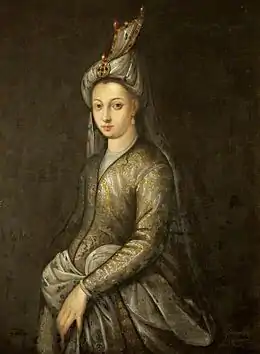
The Imperial Harem of the Ottoman sultan, which was also called seraglio in the West, was part of Topkapı Palace. It also housed the Valide Sultan, as well as the sultan's daughters and other female relatives. Eunuchs and servant girls were also part of the harem. During the later periods, the sons of the sultan lived in the Harem until they were 12 years old.[35]
It is being more commonly acknowledged today that the purpose of harems during the Ottoman Empire was for the royal upbringing of the future wives of noble and royal men. These women would be educated so that they were able to appear in public as a royal wife.[36]
Some women of Ottoman harem, especially wives, mothers and sisters of sultans, played very important political roles in Ottoman history, and in times it was said that the empire was ruled from harem. This period of Ottoman history is known as the Sultanate of Women. Hürrem Sultan (wife of Suleiman the Magnificent, mother of Selim II), was one of the most powerful women in Ottoman history, and wielded vast political power. The title of Haseki Sultan, was created for her and was used by her successors.
Kösem Sultan was also one of the most powerful women in Ottoman history.[37] Kösem Sultan achieved power and influenced the politics of the Ottoman Empire when she became Haseki Sultan as favourite consort and later legal wife of Ottoman Sultan Ahmed I (r. 1603–1617) and Valide Sultan[38] as mother of Murad IV (r. 1623–1640) and Ibrahim (r. 1640–1648), and grandmother of Mehmed IV (r. 1648–1687).
Kösem's son, Sultan Ibrahim the Mad, Ottoman ruler from 1640 to 1648, is said to have drowned 280 concubines of his harem in the Bosphorus.[39][40] At least one of his concubines, Turhan Sultan, a Rus' girl (from the area around modern Ukraine) who came into the Ottoman empire as a slave sold by Nogai slavers, survived his reign.
In Istanbul, the separation of men's and women's quarters was never practiced among the poor, and by 1920s and 1930s it had become a thing of the past in middle and upper-class homes.[41]
Mughal Empire
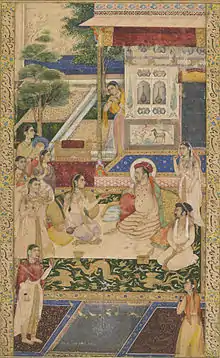
The king's wives, concubines, dancing girls and slaves were not the only women of the Mughal harem. Many others, including the king's mother lived in the harem. Aunts, grandmothers, sisters, daughters and other female relatives of the king all lived in the harem. Male children also lived in the harem until they grew up. Within the precincts of the harem were markets, bazaars, laundries, kitchens, playgrounds, schools and baths. The harem had a hierarchy, its chief authorities being the wives and female relatives of the emperor and below them were the concubines.[42]
Urdubegis were the class of women assigned to protect the emperor and inhabitants of the zenana. Because the women of the Mughal court lived sequestered under purdah, the administration of their living quarters was run entirely by women.[43] The division of the administrative tasks was dictated largely by the vision of Akbar, who organized his zenana of over 5,000 noble women and servants.[44] The women tasked with the protection of the zenana were commonly of Habshi, Tatar, Turk and Kashmiri origin. Kashmiri women were selected because they did not observe purdah. Many of the women were purchased as slaves, and trained for their positions.[45]
The women of the Mughal harem could exercise enormous political power. Nur Jahan, chief consort of Jahangir, was the most powerful and influential woman at court during a period when the Mughal Empire was at the peak of its power and glory. More decisive and proactive than her husband, she is considered by historians to have been the real power behind the throne for more than fifteen years. Nur Jahan was granted certain honours and privileges which were never enjoyed by any Mughal empress before or after. Nur Jahan was the only Mughal empress to have coinage struck in her name.[46] She was often present when the Emperor held court, and even held court independently when the Emperor was unwell. She was given charge of his imperial seal, implying that her perusal and consent were necessary before any document or order received legal validity. The Emperor sought her views on most matters before issuing orders. The only other Mughal empress to command such devotion from her husband was Nur Jahan's niece Mumtaz Mahal, for whom Shah Jahan built the Taj Mahal as a mausoleum. However, Mumtaz took no interest in affairs of state and Nur Jahan is therefore unique in the annals of the Mughal Empire for the political influence she wielded.
Safavid Empire
The royal harem played an important role in the history of Safavid Persia. In the early Safavid period, young princes were placed in the care of a lala (high-ranking Qizilbash chief who acted as a guardian) and eventually given charge of important governorates.[47] Although this system had the danger of encouraging regional rebellions against the shah, it gave the princes education and training which prepared them for dynastic succession.[47] This policy was changed by Shah Abbas I (1571-1629), who "largely banished" the princes to the harem, where their social interactions were limited to the ladies of the harem and eunuchs.[48] This deprived them of administrative and military training as well as experience of dealing with the aristocracy of the realm, which, together with the princes' indulgent upbringing, made them not only unprepared to carry out royal responsibilities, but often also uninterested in doing so.[48] The confinement of royal princes to the harem was an important factor contributing to the decline of the Safavid dynasty.[47][49]
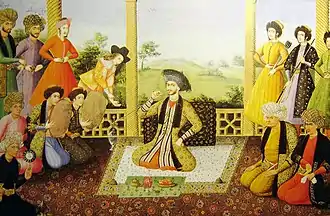
The administration of the royal harem constituted an independent branch of the court, staffed mainly by eunuchs.[50] These were initially black eunuchs, but white eunuchs from Georgia also began to be employed from the time of Abbas I.[50] The mothers of rival princes together with eunuchs engaged in palace intrigues in an attempt to place their candidate on the throne.[47] From the middle of the sixteenth century, rivalries between Georgian and Circassian women in the royal harem gave rise to dynastic struggles of an ethnic nature previously unknown at the court.[51] When Shah Abbas II died in 1666, palace eunuchs engineered the succession of Suleiman I and effectively seized control of the state.[52][53] Suleiman set up a privy council, which included the most important eunuchs, in the harem, thereby depriving traditional state institutions of their functions.[52] The eunuchs' influence over military and civil affairs was checked only by their internal rivalries and the religious movement led by Muhammad Baqir Majlisi.[53] The royal harem reached such proportions under Sultan Husayn (1668–1726) that it consumed a large part of state revenues.[53] After the fall of the Safavid dynasty, which occurred soon afterwards, eunuchs were never again able to achieve significant political influence as a class in Persia.[53]
Morocco
Moulay Ismail, Alaouite sultan of Morocco from 1672 to 1727, had over 500 concubines.[54] He is said to have fathered a total of 525 sons and 342 daughters by 1703 and achieved a 700th son in 1721.[55]
Modern Era
The practice of female seclusion witnessed a sharp decline in the early 20th century as a result of education and increased economic opportunity for women, as well as Western influences, but it is still practiced in some parts of the world, such as rural Afghanistan and conservative states of the Persian Gulf region.[7][4] Since the early 1980s, a rise in conservative Islamic currents has led to a greater emphasis on traditional notions of modesty and gender segregation, with some radical preachers in Saudi Arabia calling for a return to seclusion of women and an end of female employment. Many working women in conservative societies have adopted hijab as a way of coping with a social environment where men are uncomfortable interacting with women in the public space. Some religious women have tried to emulate seclusion practices abandoned by their grandmothers' generation in an effort to affirm traditional religious values in the face of pervasive Westernization.[7]
Eunuchs, slavery and imperial harems
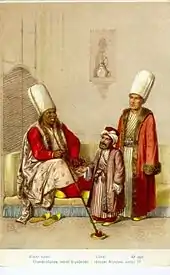
Eunuchs were probably introduced into Islam through the influence of Persian and Byzantine imperial courts.[56] The Ottomans employed eunuchs as guardians of the harem. Istanbul's Topkapı Palace housed several hundred eunuchs in the late-sixteenth century. The head eunuch who guarded the entrance of the harem was known as kızlar ağası.[57] Eunuchs were either Nilotic slaves captured in the Nile vicinity and transported through ports in Upper Egypt, the Sudan and Abyssinia,[58] or European slaves such as Slavs and Franks.[56]
According to Encyclopedia of Islam, castration was prohibited in Islamic law "by a sort of tacit consensus" and eunuchs were acquired from Christian and Jewish traders.[59] Al-Muqaddasi identifies a town in Spain where the operation was performed by Jews and the survivors were then sent overseas.[59] Encyclopedia Judaica states that Talmudic law counts castration among mutilations entitling a slave to immediate release, so that the ability of Jewish slave traders to supply eunuchs to harems depended on whether they could acquire castrated males.[60]
The dark eunuch was held as the embodiment of the sensual tyranny that held sway in the fantasized Ottoman palace, for he had been "clipped" or "completely sheared" to make of him the "ultimate slave" for the supreme ruler.[61] In the Ottoman court, white eunuchs, who were mostly brought from castration centers in Christian Europe and Circassia, were responsible for much of the palace administration, while black eunuchs, who had undergone a more radical form of castration, were the only male slaves employed in the royal harem.[62]
The chief black eunuch, or the Kizlar Agha, came to acquire a great deal of power within the Ottoman Empire. He not only managed every aspect of the Harem women's lives but was also responsible for the education and social etiquette of the princes and young women in the Harem. He arranged for all ceremonial events within the Harem including weddings and circumcision parties, and even notified women of death sentences when "accused of crimes or implicated in intrigues of jealousy and corruption."[63]
Nineteenth-century travelers accounts tell of being served by black eunuch slaves.[64] The trade was suppressed in the Ottoman Empire beginning in the mid-19th century, and slavery was legally abolished in 1887 or 1888.[65] Late 19th-century slaves in Palestine included enslaved Africans and the sold daughters of poor Palestinian peasants. Both Arabs and Jews owned slaves.[65] Circassians and Abazins from North of the Black Sea may have also be involved in the Ottoman slave trade.[66]
Similar institutions in other cultures
In Muscovite Russia the area of aristocratic houses where women were secluded was known as terem.[21]
In Mexico, Aztec ruler Montezuma II, who met Cortes, kept 4,000 concubines; every member of the Aztec nobility was supposed to have had as many consorts as he could afford.[67]
Harem is also the usual English translation of the Chinese language term hougong (hou-kung; Chinese: 後宮; lit. 'the palace(s) behind'), in reference to the Imperial Chinese Harem. Hougong refers to the large palaces for the Chinese emperor's consorts, concubines, female attendants and eunuchs. The women who lived in an emperor's hougong sometimes numbered in the thousands. In 1421, Yongle Emperor ordered 2,800 concubines, servant girls and eunuchs who guarded them to a slow slicing death as the Emperor tried to suppress a sex scandal which threatened to humiliate him.
In Africa, many chieftains have traditionally had harems. The Zulu king currently has six wives, for example, and members of the Nigerian chieftaincy system have historically had as many as three hundred of them.[68][69]
Western representations
A distinct, imaginary vision of the harem emerged in the West starting from the 17th century, when Europeans became aware of Muslim harems housing numerous women. In contrast to the medieval European views, which conceived Muslim women as victimized but powerful through their charms and deceit, during the era of European colonialism the "imaginary harem" came to represent what Orientalist scholars saw as an abased and subjugated status of women in the Islamic civilization. These notions served to cast the West as culturally superior and justify the colonial enterprise.[4] Under the influence of The Thousand and One Nights, the harem was often conceived as a personal brothel, where numerous women lounged in suggestive poses, directing their strong but oppressed sexuality toward a single man in a form of "competitive lust".[3][4]
A centuries-old theme in Western culture is the depiction of European women forcibly taken into Oriental harems—evident for example in the Mozart opera Die Entführung aus dem Serail ("The Abduction from the Seraglio") concerning the attempt of the hero Belmonte to rescue his beloved Konstanze from the seraglio/harem of the Pasha Selim; or in Voltaire's Candide, in chapter 12 of which the old woman relates her experiences of being sold into harems across the Ottoman Empire.
Much of Verdi's opera Il corsaro takes place in the harem of the Pasha Seid—where Gulnara, the Pasha's favorite, chafes at life in the harem, and longs for freedom and true love. Eventually she falls in love with the dashing invading corsair Corrado, kills the Pasha and escapes with the corsair—only to discover that he loves another woman.
The Lustful Turk, a well-known British erotic novel, was also based on the theme of Western women forced into sexual slavery in the harem of the Dey of Algiers, while in A Night in a Moorish Harem, a Western man is invited into a harem and engages in forbidden sex with nine concubines. In both works, the theme of "West vs. Orient" is clearly interwoven with the sexual themes.
The Sheik novel and the Sheik film, a Hollywood production from 1921, are both controversial and probably the best known works created by exploiting the motif.[70] Much criticism ensued over decades, especially recently, on various strong and unambiguous Orientalist and colonialist elements, and in particularly directed at ideas closely related to the central rape plot in which for women, sexual submission is a necessary and natural condition, and that interracial love between an Englishwoman and Arab, a "native", is avoided, while the rape is ultimately justified by having the rapist turn out to be European rather than Arab.[71][72][73][74]
Angelique and the Sultan, part of the Angélique historical novel series by Anne and Serge Golon and later made into a film, has the theme of a 17th Century French noblewoman captured by pirates and taken into the harem of the King of Morocco. Thereupon, she stabs the King with his own dagger when he tries to have sex with her and stages a daring escape.
The Russian writer Leonid Solovyov, adapting the Middle Eastern and Central Asian folktales of Nasreddin into his book Возмутитель спокойствия (English translations under the varying titles "The Beggar in the Harem: Impudent Adventures in Old Bukhara", 1956, and "The Tale of Hodja Nasreddin: Disturber of the Peace", 2009[75]) added prominently the theme of Nasreddin's beloved being taken into the harem of the Emir of Bukhara and the protagonist's efforts to extract her from there - a theme completely absent from the original folktales.
A Study in Scarlet, the first of Conan Doyle's Sherlock Holmes mysteries, applies many of the above conventions to the historically different phenomenon of Mormon polygamous marriage. In the wild days of early Mormon settlement of Utah, the protagonist's beloved is kidnapped and placed against her will in the harem of a Mormon elder, where she dies. Having failed to rescue her, the protagonist is bent on deadly revenge on the kidnappers - which is the background to the mystery solved by Holmes.
In H.G. Wells' The War in the Air, civilization breaks down due to global war. With England reverting to barbarism, a local strongman takes over a town and among other things starts forcing young women into a harem which he is building up. The protagonist must fight and kill him in order to save his girlfriend from being included.
Image gallery
Many Western artists have depicted their imaginary conceptions of the harem.
- Depictions of Harems
 The Pasha in His Harem by Francois Boucher c. 1735-1739
The Pasha in His Harem by Francois Boucher c. 1735-1739 Scene from the Harem, Jean-Baptiste van Mour (1st half of the 18th century)
Scene from the Harem, Jean-Baptiste van Mour (1st half of the 18th century)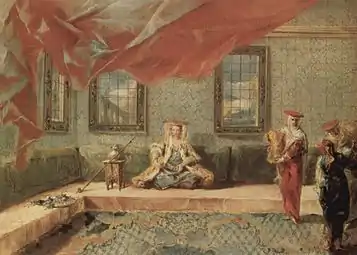 Scene in a Harem, by Guardi
Scene in a Harem, by Guardi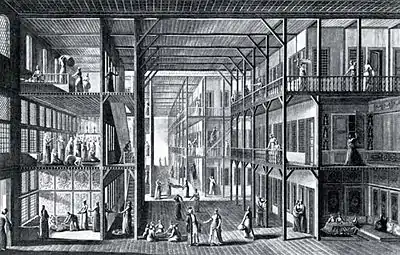 The Harem as imagined by European artist, The Dormitory of the Concubines, by Ignace Melling, 1811.
The Harem as imagined by European artist, The Dormitory of the Concubines, by Ignace Melling, 1811.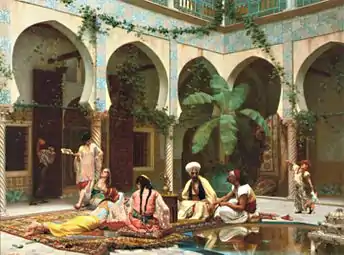 Gustave Boulanger: The Harem
Gustave Boulanger: The Harem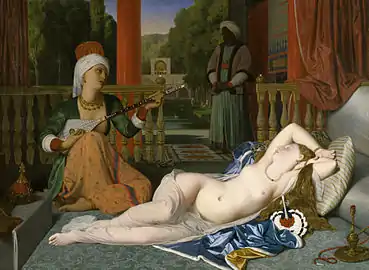 Harem scene by Dominique Ingres
Harem scene by Dominique Ingres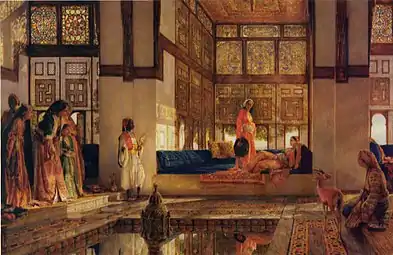 The Reception, John Frederick Lewis, 1805-1875, English
The Reception, John Frederick Lewis, 1805-1875, English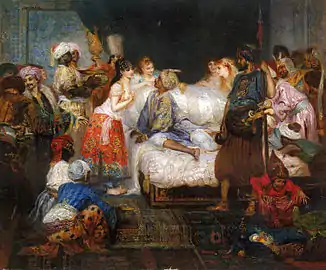 Scene from the Harem by Fernand Cormon, c. 1877
Scene from the Harem by Fernand Cormon, c. 1877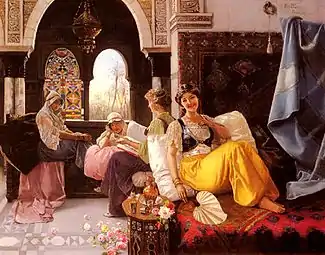 Harem Scene, Quintana Olleras, 1851-1919, Spanish
Harem Scene, Quintana Olleras, 1851-1919, Spanish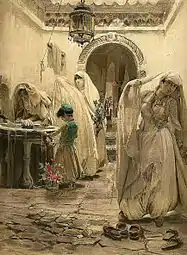 The Harem Fountain, Frederick Arthur Bridgman, 1847-1928, American
The Harem Fountain, Frederick Arthur Bridgman, 1847-1928, American Belle of Nelson whiskey poster (1878), based on a harem scene by Jean-Léon Gérôme.
Belle of Nelson whiskey poster (1878), based on a harem scene by Jean-Léon Gérôme. In the harem, Lehnert & Landrock postcard, 1900s-1910s
In the harem, Lehnert & Landrock postcard, 1900s-1910s_-_Ad_6.jpg.webp) The Virgin of Stamboul, 1920 film poster
The Virgin of Stamboul, 1920 film poster
See also
Places
- Arcadia (utopia)
- Gynaeceum
- Turkish bath (hammam)
- Ōoku
- Seraglio
- Zenana
Bibliography
Citations
- Hans Wehr, J. Milton Cowan (1976). A Dictionary of Modern Written Arabic (3rd ed.). Spoken Language Services. pp. 171–172.
- Harem at WordReference.com
- Cartwright-Jones, Catherine (2013). "Harem". The Oxford Encyclopedia of Islam and Women. Oxford: Oxford University Press. ISBN 9780199764464.
- Anwar, Etin (2004). "Harem". In Richard C. Martin (ed.). Encyclopedia of Islam and the Muslim World. MacMillan Reference USA.
- Harem in Merriam-Webster Dictionary
- Elfriede Haslauer (2005). "Harem". The Oxford Encyclopedia of Ancient Egypt. Oxford: Oxford University Press. ISBN 9780195102345.
- Eleanor Abdella Doumato (2009). "Seclusion". In John L. Esposito (ed.). The Oxford Encyclopedia of the Islamic World. Oxford: Oxford University Press.
- Madar 2011.
- Britannica 2002.
- Wehr 1976, pp. 171-172.
- Quataert 2005, p. 152.
- Youshaa Patel (2013). "Seclusion". The Oxford Encyclopedia of Islam and Women. Oxford: Oxford University Press.
- "harem". Dictionary.com Unabridged. Random House. Retrieved 2017-04-04.
- Betzig 2013.
- Ahmed 1992, p. 103.
- Ahmed 1992, pp. 26-28.
- Ahmed 1992, p. 27.
- Schi̇ck, İrvi̇n Cemi̇l (2009). "Space: Harem: Overview". In Suad Joseph (ed.). Encyclopedia of Women & Islamic Cultures. Brill. doi:10.1163/1872-5309_ewic_EWICCOM_0283.
-
 Chisholm, Hugh, ed. (1911). "Harem". Encyclopædia Britannica (11th ed.). Cambridge University Press.
Chisholm, Hugh, ed. (1911). "Harem". Encyclopædia Britannica (11th ed.). Cambridge University Press. - A. Shapur Shahbazi (2012). "HAREM i. IN ANCIENT IRAN". Encyclopaedia Iranica.
- Mary Ann Fay (2012). Unveiling the Harem: Elite Women and the Paradox of Seclusion in Eighteenth-Century Cairo. Syracuse University Press. pp. 38–39. ISBN 9780815651703.
- Edmund Burke; Nejde Yaghoubian (2006). Struggle and Survival in the Modern Middle East. University of California Press. p. 48. ISBN 9780520246614.
- Ahmed, Leila (1992). Women and Gender in Islam. New Haven: Yale University Press. pp. 26–28.
- Kumkum Chatterjee. "Purdah". In Colin Blakemore; Sheila Jennett (eds.). The Oxford Companion to the Body. p. 570.
Purdah [...] refers to the various modes of shielding women from the sight primarily of men (other than their husbands or men of their natal family) in the South Asian subcontinent. [...] The purdah, as veiling, was possibly influenced by Islamic custom, [...] But, in the sense of seclusion and the segregation of men and women, purdah predates the Islamic invasions of India.
- Upinder Singh (2008). A History of Ancient and Early Medieval India: From the Stone Age to the 12th century. Pearson Education. p. 332. ISBN 978-81-317-1677-9.
- Keddie, Nikki (Spring 1990). "The Past and Present of Women in the Muslim World". Journal of World History. 1 (1): 77–108.
- Siddiqui, Mona (2006). "Veil". In Jane Dammen McAuliffe (ed.). Encyclopaedia of the Qurʾān. Brill.
- [Quran 33:53 (Translated by Yusuf Ali)]
- Ahmed 1992, pp. 112–15.
- Morony, Michael G. Iraq after the Muslim conquest. Gorgias Press LLC, 2005
- Abbott, Nabia. Two queens of Baghdad: mother and wife of Hārūn al Rashīd. University of Chicago Press, 1946.
- Ahmed 1992, p. 85.
- Ahmed 1992, p. 87.
- Qutbuddin, Tahera (2006). "Women Poets" (PDF). In Josef W. Meri (ed.). Medieval Islamic Civilization: An Encyclopedia. II. New York, NY: Routledge. pp. 865–867. ISBN 978-0-415-96690-0. Archived from the original (PDF) on 7 February 2014. Retrieved 29 March 2015.;
Samer M. Ali, 'Medieval Court Poetry', in The Oxford Encyclopedia of Islam and Women, ed. by Natana J. Delong-Bas, 2 vols (Oxford: Oxford University Press, 2013), I 651-54 (at p. 652). https://www.academia.edu/5023780. - Ansary 2009, p. 228.
- Goodwin 1997, p. 127.
- Peirce, Leslie (1993). The Imperial Harem: Women and Sovereignty in the Ottoman Empire. Oxford University Press. pp. 105. ISBN 0-19-508677-5.
While Hurrem was the woman of the Ottoman dynasty best known in Europe, it is Kösem who is remembered by the Turks as the most powerful.
- Douglas Arthur Howard, The official History of Turkey, Greenwood Press, ISBN 0-313-30708-3, p. 195
- "Old World Empires: Cultures of Power and Governance in Eurasia". Ilhan Niaz (2014). p.296. ISBN 1317913787
- Dash, Mike (22 March 2012). "The Ottoman Empire's Life-or-Death Race". Smithsonian.com.
- Duben & Behar 2002, p. 223.
- Sharma, Anjali (28 November 2013). "Inside the harem of the mughals". The New Indian Express.
- Lal, K.S. (1988). The Mughal Harem. New Delhi: Aditya Prakashan. pp. 14, 52–55. ISBN 8185179034.
- Abu 'l-Fazl Allami (1977). Phillot, Lieut. Colonel D.C. (ed.). The Ain-i Akbari. Trans. H. Blochman. Delhi: Munishram Manoharlal. pp. 45–47. ISBN 9788186142240.
- Hambly, Gavin (1998). "Armed Women Retainers in the Zenanas of Indo-Muslim Rulers: The case of Bibi Fatima". Women in the medieval Islamic world : Power, patronage, and piety. New York: St. Martin's Press. pp. 431–433. ISBN 0312210574.
- Nath 1990, p. 64
- R.M. Savory (1977). "Safavid Persia". In P. M. Holt; Ann K. S. Lambton; Bernard Lewis (eds.). The Cambridge History of Islam. The Central Islamic Lands from Pre-Islamic Times to the First World War. Volume 1A. Cambridge University Press. p. 424.
- H.R. Roemer (1986). "The Safavid Period". In William Bayne Fisher; Peter Jackson; Lawrence Lockhart (eds.). The Cambridge History of Iran. 6. Cambridge University Press. pp. 277–278.
- H.R. Roemer (1986). "The Safavid Period". In William Bayne Fisher; Peter Jackson; Lawrence Lockhart (eds.). The Cambridge History of Iran. 6. Cambridge University Press. p. 330.
- R.M.Savory (1986). "The Safavid Administrative System". In William Bayne Fisher; Peter Jackson; Lawrence Lockhart (eds.). The Cambridge History of Iran. 6. Cambridge University Press. p. 355.
- R.M.Savory (1986). "The Safavid Administrative System". In William Bayne Fisher; Peter Jackson; Lawrence Lockhart (eds.). The Cambridge History of Iran. 6. Cambridge University Press. p. 363.
- H.R. Roemer (1986). "The Safavid Period". In William Bayne Fisher; Peter Jackson; Lawrence Lockhart (eds.). The Cambridge History of Iran. 6. Cambridge University Press. p. 307.
- A.K.S. Lambton (1978). "K̲h̲āṣī (II.—In Persia)". In P. Bearman; Th. Bianquis; C.E. Bosworth; E. van Donzel; W.P. Heinrichs (eds.). Encyclopaedia of Islam. 4 (2nd ed.). Brill. p. 1092.
- "Morocco poll - choice or façade?". BBC News. September 1, 2007.
- "Some magical Moroccan records". Guinness World Records. Guinness World Records Limited. March 3, 2008. Archived from the original on March 13, 2010. Retrieved March 20, 2010.
- Marzolph 2004.
- Rodriguez 1997.
- Abir, Mordechai (1968). Ethiopia: the era of the princes: the challenge of Islam and re-unification of the Christian Empire, 1769-1855. Praeger. pp. 57–60.
- Pellat, Ch.; Lambton, A.K.S.; Orhonlu, Cengiz (2012). "K̲h̲āṣī". In P. Bearman; Th. Bianquis; C.E. Bosworth; E. van Donzel; W.P. Heinrichs (eds.). Encyclopaedia of Islam (2nd ed.). Brill. doi:10.1163/1573-3912_islam_COM_0499.
- Arcadius Kahan. "Economic History". Encyclopaedia Judaica. 6.
- Lad, Jateen (2010). "Panoptic Bodies: Black Eunuchs as Guardians of the Topkapı Harem". In Booth, Marilyn. Harem Histories: Envisioning Places and Living Spaces. Duke University Press. pp. 136–137. ISBN 978-0822348696.
- Ronald Segal (2002). Islam's Black Slaves: The Other Black Diaspora. Macmillan. p. 109. ISBN 9780374527976.
- 1892-1960., Penzer, N. M. (Norman Mosley) (2005). The harem : inside the Grand Seraglio of the Turkish sultans. Mineola, N.Y.: Dover. ISBN 978-0486440040. OCLC 57211338.CS1 maint: numeric names: authors list (link)
- Through Samaria to Galilee and the Jordan: Scenes of the Early Life and Labors of Our Lord, Josias Porter, 1889, Thomas Nelson and Sons, London, Edinburgh, and New York, reprinted by Kessinger Publishing, 2005, p. 242.
- Joseph Glass and Ruth Kark. "Sarah La Preta: A Slave in Jerusalem". Jerusalem Quarterly. 34: 41–50.
- Faroqhi 2011.
- Sex in History, March 1994, Michigan Today
- Toyin Falola and Matt D. Childs (2005), The Yoruba Diaspora in the Atlantic World, pp. 64-67.
- "Zulu King's Sixth Wife Needs Palace". BBC. September 5, 2012. Retrieved May 4, 2020.
- "The Sheik". University of Pennsylvania Press website. Accessed Oct. 20, 2015.
- "Sheiks & Terrorists - Reclaiming Identity: Dismantling Arab Stereotypes". www.arabstereotypes.org. Retrieved 8 September 2016.
- J., Dajani, Najat Z. (1 January 2000). "Arabs in Hollywood : Orientalism in film". doi:10.14288/1.0099552. Retrieved 8 September 2016. Cite journal requires
|journal=(help) - Hsu-Ming Teo. "Historicizing The Sheik: Comparisons of the British Novel and the American Film". Journal of Popular Romance Studies. Retrieved 8 September 2016.
- Hsu-Ming Teo (2012). Desert Passions: Orientalism and Romance Novels. University of Texas Press. ISBN 9780292739390.
- Solovyov, Leonid (2009). The Tale of Hodja Nasreddin: Disturber of the Peace. Toronto, Canada: Translit Publishing. ISBN 978-0-9812695-0-4.
Sources
- Ahmed, Leila (1992). Women and Gender in Islam. New Haven: Yale University Press.
- Ansary, Tamim (2009). Destiny disrupted: a history of the world through Islamic eyes. New York: PublicAffairs. p. 228. ISBN 9781586486068.
- Anwar, Etin (2004). "Harem". In Richard C. Martin (ed.). Encyclopedia of Islam and the Muslim World. MacMillan Reference USA.
- Betzig, Laura (March 1994). "Sex in History". Michigan Today. University of Michigan. Archived from the original on 11 September 2013.
- Britannica (2002). "Harem". Encyclopaedia Britannica.
- Cartwright-Jones, Catherine (2013). "Harem". The Oxford Encyclopedia of Islam and Women. Oxford: Oxford University Press. doi:10.1093/acref:oiso/9780199764464.001.0001. ISBN 9780199764464.
- Duben, Alan; Behar, Cem (2002). Istanbul Households: Marriage, Family and Fertility, 1880-1940. Cambridge University Press. ISBN 9780521523035.
- Fay, Mary Ann (2012). Unveiling the Harem: Elite Women and the Paradox of Seclusion in Eighteenth-Century Cairo. Syracuse University Press. ISBN 9780815651703.
- Goodwin, Godfrey (1997). The Private World of Ottoman Women. London: Saqi Books. ISBN 9780863567513.
- Haslauer, Elfriede (2005). "Harem". The Oxford Encyclopedia of Ancient Egypt. Oxford: Oxford University Press. doi:10.1093/acref/9780195102345.001.0001. ISBN 9780195102345.
- Faroqhi, Suraiya (2006). The Ottoman Empire and the World Around It.
- Madar, Heather (2011). "Before the Odalisque: Renaissance Representations of Elite Ottoman Women". Early Modern Women. 6: 1–41.
- Marzolph, Ulrich (2004). "Eunuchs". The Arabian Nights Encyclopedia. ABC-CLIO.
- Quataert, Donald (2005). The Ottoman Empire, 1700-1922. Cambridge University Press. ISBN 9780521839105.
- Rodriguez, J.P. (1997). "Ottoman Empire". The Historical Encyclopedia of World Slavery. ABC-CLIO.
- Wehr, Hans; Cowan, J. Milton (1976). A Dictionary of Modern Written Arabic (3rd ed.). Spoken Language Services.
Further reading
- İlhan Akşit. The Mystery of the Ottoman Harem. Akşit Kültür Turizm Yayınları. ISBN 975-7039-26-8
- Alev Lytle Croutier. Harem: The World Behind the Veil, reprint ed. Abbeville Publishing Group (Abbeville Press, Inc.), 1998. ISBN 1-55859-159-1 (first published by Abbeville Press in 1989).
- Alev Lytle Croutier. Harem: The World Behind the Veil, 25th anniversary edition. New York Abbeville Press, 2014 ISBN 978-0-7892-1206-1
- Alan Duben, Cem Behar, Richard Smith (Series editor), Jan De Vries (Series editor), Paul Johnson (Series editor), Keith Wrightson (Series editor). Istanbul Households: Marriage, Family and Fertility, 1880-1940, new ed. Cambridge University Press, 2002. ISBN 0-521-52303-6
- John Freely. Inside the Seraglio: Private Lives of the Sultans in Istanbul: The Sultan's Harem, new ed. Penguin (Non-Classics), 2001. ISBN 0-14-027056-6
- Shapi Kaziev. Concubines. The secret life of the eastern harem ISBN 978-5-906842-39-8
- Kishori Saran Lal (1988). The Mughal Harem. New Delhi: Aditya Prakashan. ISBN 978-81-85179-03-2.
- Reina Lewis. Rethinking Orientalism: Women, Travel, And The Ottoman Harem. Rutgers University Press, 2004 ISBN 9780813535432
- Fatima Mernissi. Dreams of Trespass: Tales of a Harem Girlhood. Perseus, 1994
- Leslie P. Peirce. The Imperial Harem: Women and Sovereignty in the Ottoman Empire, new ed. Oxford University Press USA, 1993. ISBN 0-19-508677-5
- N. M. Penzer. The Harēm : Inside the Grand Seraglio of the Turkish Sultans. Dover Publications, 2005. ISBN 0-486-44004-4 (reissue of: The Harēm: An Account of the Institution as it Existed in the Palace of the Turkish Sultans with a History of the Grand Seraglio from its Foundation to the Present Time; 1936)
- M. Saalih. Harem Girl: A Harem Girl's Journal reprint ed. Delta, 2002. ISBN 0-595-31300-0 (erotic novel)
- Royal French Women in the Ottoman Sultans' Harem: The Political Uses of Fabricated Accounts from the Sixteenth to the Twenty-first Century
External links
| Wikimedia Commons has media related to Harems. |
| Wikiquote has quotations related to: Harem |
